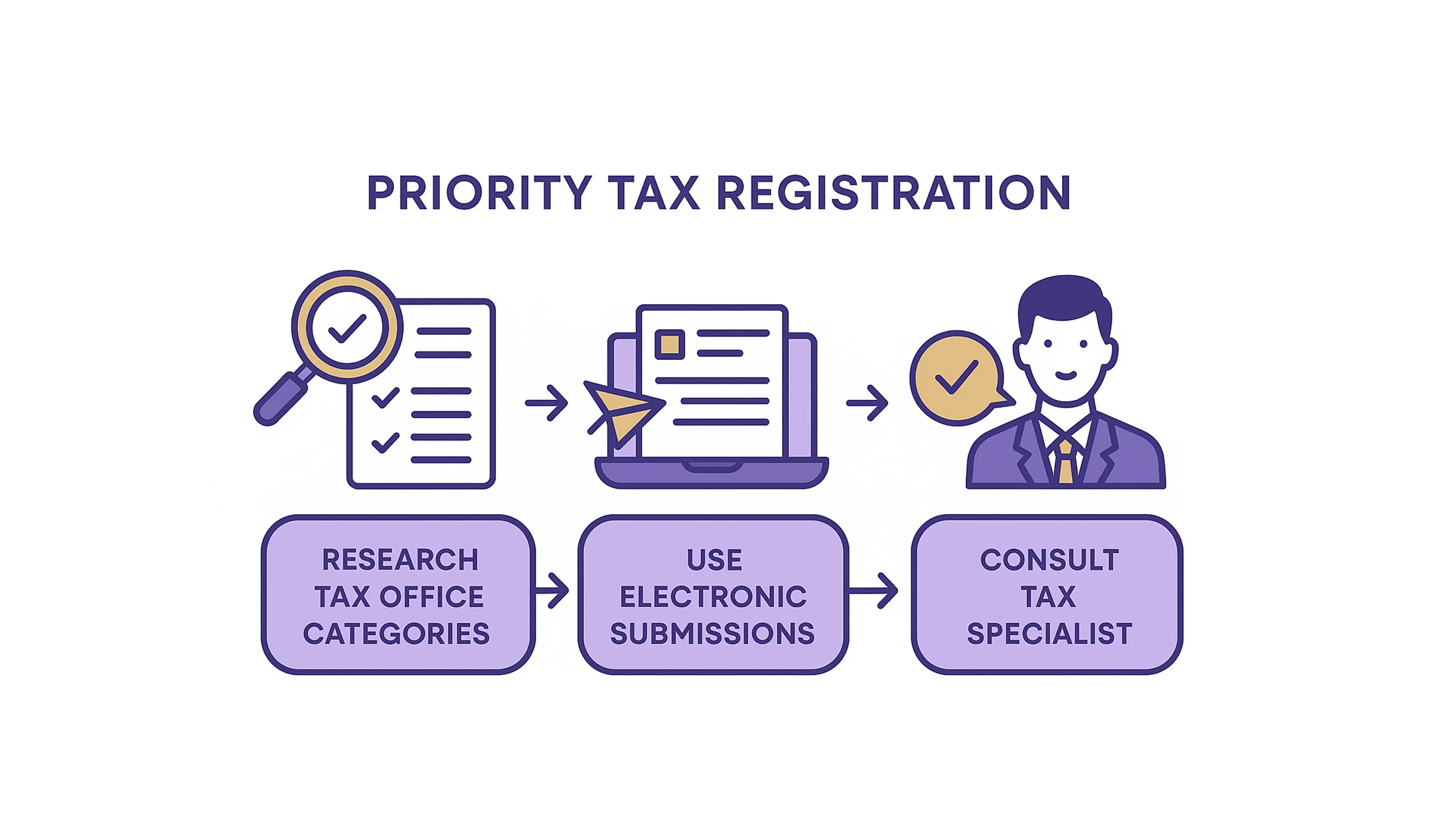Expedited VAT Registrations
Getting your VAT number fast can feel like an uphill battle. This process involves a fair amount of form-filling, constant follow-ups, and interpretation of rules that often change. Unfortunately, a 17**%** failure rate for VAT applications was reported last year, as a 2024 study indicates. Clearly, it can be a tricky venture. Yet the need for getting set up swiftly is more pressing than ever. Processing times have jumped from 30 days to 8 weeks, as June 2024 data reveals. That’s why many businesses look for a speedier path. Below is a checklist to help you achieve expedited VAT registrations while avoiding the common pitfalls.
What Are Expedited VAT Registrations?
Expedited VAT registrations refer to a prioritized approach that allows businesses to obtain their VAT number sooner than the usual wait time. This can prove vital if you're selling goods or services immediately, or operating internationally and require a VAT number quickly to comply with cross-border demands. By submitting a complete application with strong supporting evidence, you stand a better chance of approval in a shorter timeframe. For background on VAT, see The Basics of VAT.
1. Understand Priority Tax Registration to Accelerate VAT Approval

An early step is understanding what priority tax registration means. While it won’t guarantee an instant response from the tax authority, it can shorten the waiting period if done correctly.
Contact a tax specialist if you need help interpreting new regulations. Discover how professional support can help in VAT Consulting for International Businesses.
Pro Tip
Being transparent in your application helps you avoid rejections. When asked for financial projections or incorporation details, supply them clearly to minimise back-and-forth queries.
2. Confirm VAT Eligibility Criteria Before You Apply
Before rushing to apply, ensure you meet the local VAT threshold or the criteria for a value added tax identification number. Mistakes with eligibility often add weeks of delays.
-
Check whether your business meets the VAT registration threshold. In the UK, for instance, businesses must register for VAT if their annual taxable turnover exceeds £90,000, effective from 1 April 2024. This new threshold was announced in the UK Government’s official policy update. Thresholds vary across EU countries, so always consult official guidelines in your target market.
-
Evaluate if your operations are purely domestic or cross-border; some companies must register in multiple jurisdictions.
-
Keep an eye on the supporting documentation you’ll need, such as your company certificate or bank statements.
If you’re selling digital products to multiple European countries, you may qualify for special registration portals designed for businesses needing quick cross-border compliance. Details can be found in EU – Single VAT Registration and Modernization of Tax Reporting.
3. Prepare All VAT Registration Documents in Advance
Hunting for official papers at the last minute slows everything down. Put all your supporting documents in one folder. That simple step alone can make expedited VAT registrations more realistic.
-
Compile evidence of your trading address, business structure, and identity of key stakeholders.
-
Prepare proof of business activities (e.g., contracts or purchase orders) that show you need a value added tax identification number.
Keep copies of any prior VAT or tax identification numbers if you have them.
Common Issues to Avoid
-
Submitting documents in a foreign language without a certified translation.
-
Sending incomplete financial statements or missing annexes.
-
Using obsolete forms. Regulations shift often, so always download the latest templates.
-
For more mistakes to avoid, read The obligation to register for VAT: 6 common mistakes.
4. Apply for VAT via Available Frameworks
If you trade across different EU nations, certain streamlined processes can help you register faster for a VAT ID that works in multiple jurisdictions. While rules differ from one country to another, there are some universal steps:
-
Identify if you can use the One-Stop Shop (OSS) system for cross-border e-commerce - a framework introduced by the European Commission. For official guidance, refer to the Commission’s dedicated OSS webpage.
-
Check if a local fiscal representative is required; this might secure your registration in record time.
-
Stay updated on EU-level changes. Some regions have reported recent increases in VAT registrations, which can lead to longer queues but may also prompt new fast-track systems. Always consult reputable sources, such as official finance ministries, for the latest data.
-
For more on compliance strategies, see EU – Reform of SME Schemes and Simplified VAT Compliance.
Quick Updates
VAT remains one of the main sources of tax revenue across OECD countries, accounting for 20.8% of total tax income in 2022. As VAT systems evolve, some governments continue to refine registration processes. Staying informed about regulatory changes can help businesses prepare for procedural shifts and potential fast-track options.
5. Submit a Complete and Clear VAT Registration Application
An incomplete or rushed application is the biggest culprit behind extended waiting. To boost your chance of a speedier approval:
-
Fill each field carefully with consistent data: any mismatch in company name or address can trigger manual checks.
-
Explain your reason for needing a value added tax identification number (e.g., three major contracts lined up or cross-border sales about to begin).
-
Provide financial forecasts if requested - some authorities require proof that your venture is active.
-
Attach all supporting documents neatly labeled and scanned clearly.
Dealing with Questions from Tax Authorities
If tax officials follow up, answer as soon as possible. Delays in responding can push your file to the bottom of the queue. Double-check your contact details so you don't miss any messages.
6. Follow Up on Your VAT Application with a Systematic Approach
Once your application is in, waiting starts. But you can stay proactive without hassling the authorities. Here’s how:
-
Maintain a reasonable interval before sending follow-ups, typically 1–2 weeks.
-
If you have an official reference number, include it in each email for quick tracking.
-
Look for e-portal updates if your local authority provides a dashboard.
Timely Follow-ups That Work
A short, polite message works best:
-
“Hello [Name], I’m checking on my VAT registration progress. Could you please confirm if any further details are required?”
-
“I’d appreciate any update on my application submitted on [Date]. My reference number is [XYZ]. Thank you.”
7. React Quickly to VAT Application Rejections

VAT registration rejections are not uncommon, especially when documentation is incomplete or inconsistent. It’s important to address any issues promptly and follow up with the tax authority where needed.
-
Find out the exact reason for rejection; often it’s a missing or incomplete document.
-
Fix the noted issues quickly and resubmit - sometimes, you can go back into a fast-track lane.
-
If everything appears correct on your side, consider requesting an explanation in writing, politely.
For a real-world example, check out the 1stopVAT Case Study: VAT Registration Difficulties in the UK for Foreign Entities.
Why It Matters
When the application extends past the point you need to charge VAT, you risk compliance fines. That’s why speed and accuracy in your registration process can make a difference.
8. Stay Compliant After Receiving Your VAT Number
Securing a VAT number quickly isn’t the end of your obligations. You’ll still have monthly, quarterly, or annual VAT returns to file, depending on your specific reporting cycle.
-
Mark your calendar with return deadlines, especially if you handle multiple jurisdictions.
-
Be aware that many enterprises find VAT returns complex; consider using reputable accounting software (e.g., Xero or QuickBooks) or seeking guidance from professional tax advisors.
-
Stay informed about ongoing changes in VAT regulations through official websites, industry associations, or government announcements.
For more on compliance after registration, see Why should you take VAT compliance seriously? Possible consequences of VAT breaches.
Ongoing Benefits
Staying on top of these returns helps you avoid penalties that can negate the advantage of any expedited VAT registration. It also keeps your business records clean, which is important if you plan to expand.
Conclusion
Securing expedited VAT registrations involves more than just sending forms; it’s about clarity, consistency, and timely follow-ups. Every step of this checklist - from confirming eligibility to managing ongoing compliance - helps you avoid the major stumbling blocks that cause rejection or delays. By approaching your registration in a structured way, you’ll be better prepared to handle the shifting rules and requirements that come with VAT. Whether you’re applying for an expedited process or a straightforward home-country registration, set your documents and timeline in good order, and you’ll navigate the system with fewer headaches.



